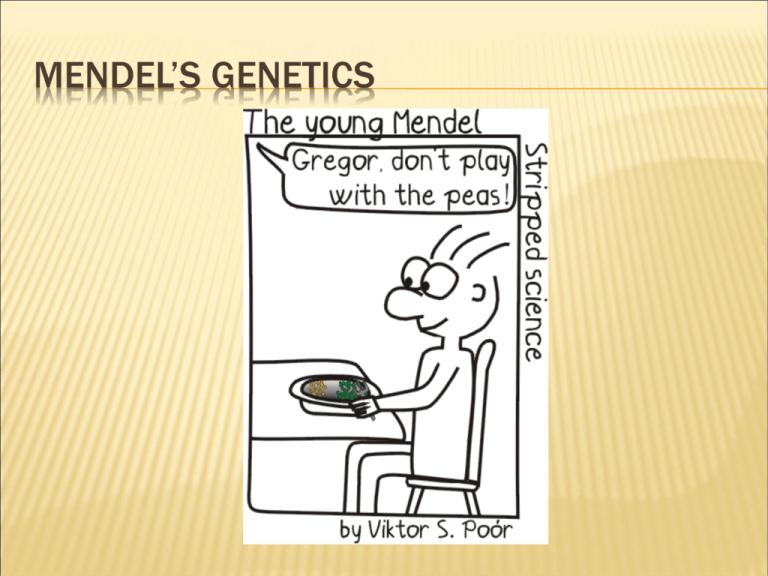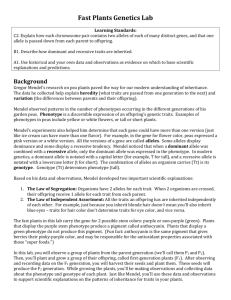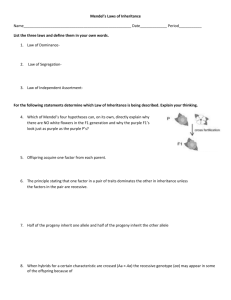m3 Chapter 4
advertisement

MENDEL’S GENETICS WHO IS HE? Gregor Mendel Ordained priest Father of modern genetics GREGOR MENDEL Raised on farm and understood the value of plant breeding. At 21, entered priesthood and studied plant breeding in a monastery in the Czech Republic. Loved to read especially about natural sciences and was aware of Darwin’s findings. Studied the inheritance of traits in pea plants. WHAT DID HE DO? • • • Research with pea plants Developed ideas of dominance and trait segregation One of the first scientists to use the scientific method and mathematical models MENDEL CHOSE PEAS WISELY • Pea plants are good for genetic research – available in many varieties with distinct heritable features with different variations • flower color, seed color, seed shape, etc. Mendel had strict control over which plants mated with which • each pea plant has male & female structures • pea plants can self-fertilize • Mendel could also cross-pollinate plants: moving pollen from one plant to another MENDEL CHOSE PEAS LUCKILY • most characters are controlled by a single gene • each gene has only 2 alleles, one of which is completely dominant to the other HIS STUDIES • Observed peas to determine what traits were inherited He noticed at least 7 characteristics that appeared to be inherited Characters investigated • by Mendel VOCABULARY Character –heritable feature Trait – each variant for a character True-breeding – plants that self-pollinate all offspring are the same variety Monohybrid cross – a cross that tracks the inheritance of a single character P generation – (parental) true-breeding F1- (first filial) offspring of P generation F2 – (second filial) offspring from F1 cross VOCABULARY (CONTINUED) Allele- alternate version of a gene Dominate allele – expressed in the heterozygote Recessive allele – not expressed in the heterozygote Homozygote – pair of identical alleles for a character Homozygous dominant- BB Homozygous recessive - bb Heterozygote – two different alleles for a character (Bb) Genotype – genetic makeup Phenotype – appearance of an organism Mendel crossed purebred plants with opposite forms of a trait. He called these plants the parental generation , or P generation. For instance, purebred tall plants were crossed with purebred short plants. Parent Short P generation Parent Tall P generation Mendel observed that all of the offspring grew to be tall plants. None resembled the short parent. He called this generation of offspring the first filial , or F1 generation, (The word filial means “son” in Latin.) Parent Short Offspring Tall P generation F1 generation Parent Tall P generation EXPERIMENT 1 (PART 2) Mendel then crossed two of the offspring tall plants (F1) produced from his first experiment. F1 Tall F1 Tall ¾ Tall & ¼ Short F2 Generation Mendel called this second generation of plants the second filial, F2, generation. To his surprise, Mendel observed that this generation had a mix of tall and short plants. This occurred even though none of the F1 parents were short. THE PUNNETT SQUARE Mendelian Genetics Classical Punett's Square is a way to determine ways traits can segregate parental P0 cross a a A Aa Aa F1 cross A Aa Aa A AA Aa A a a Aa aa backcross: mating F1 generation to the parental (usually recessive) strain A a a Aa aa a Aa aa in this backcross, F2 generation gives 50% (1:1) recessive offspring test cross: mating to a homozygous recessive individual LAW OF SEGREGATION states that allele pairs separate or segregate during gamete formation, and randomly unite at fertilization. There are four main concepts involved in this idea. They are: 1. There are alternative forms for genes. This means that a gene can exist in more than one form. For example, the gene that determines pod color can either be (G) for green pod color or (g) for yellow pod color. 2. 2. For each characteristic or trait organisms inherit two alternative forms of that gene, one from each parent. These alternative forms of a gene are called alleles LAW OF SEGREGATION 3. When gametes (sex cells) are produced, allele pairs separate or segregate leaving them with a single allele for each trait. This means that sex cells contain only half the compliment of genes. When gametes join during fertilization the resulting offspring contain two sets of alleles, one allele from each parent. For example, the sex cell for the green pod plant had a single (G) allele and the sex cell for the yellow pod plant had a single (g) allele. After fertilization the resulting F1 plants had two alleles (Gg). 4. When the two alleles of a pair are different, one is dominant and the other is recessive. CROSS-POLLINATION OF PUREBREAD PLANTS cross-pollination between true breeding green and yellow pods - all F1 green F1 Generation Gg =heterozygous When Mendel performed cross-pollination between a true-breeding yellow pod plant and a true-breeding green pod plant, he noticed that all of the resulting offspring, F1 generation, were green. F2 GENERATION - self-pollination of green F1 plants - ¾ in F2 green, ¼ yellow - 3 : 1 ratio in pod colour in F2 G = dominant = green g = recessive = yellow GG, gg =homozygous He then allowed all of the green F1 plants to self-pollinate. He referred to these offspring as the F2 generation. Mendel noticed a 3:1 ratio in pod color. About 3/4 of the F2 plants had green pods and about 1/4 had yellow pods. From these experiments Mendel formulated what is now known as Mendel's law of segregation. SEED COLOUR C = dominant = yellow c = recessive = green INHERITANCE OF PEA COLOUR phenotype: genotype: ALL THE REST… LAW OF INDEPENDANT ASSORTMENT This law states that allele pairs separate independently during the formation of gametes. Therefore, traits are transmitted to offspring independently of one another. Mendel performed dihybrid crosses in plants that were true-breeding for two traits. For example, a plant that had green pod color and yellow seed color was cross-pollinated with a plant that had yellow pod color and green seeds. In this cross, the traits for green pod color (GG) and yellow seed color (YY) are dominant. Yellow pod color (gg) and green seed color (yy) are recessive. The resulting offspring (or F1 generation were all heterozygous for green pod color and yellow seeds (GgYy). LAW OF INDEPENDANT ASSORTMENT Mendel performed dihybrid crosses in plants that were truebreeding for two traits. For example, a plant that had green pod color and yellow seed color was cross-pollinated with a plant that had yellow pod color and green seeds. In this cross, the traits for green pod color (GG) and yellow seed color (YY) are dominant. Yellow pod color (gg) and green seed color (yy) are recessive. The resulting offspring (or F1 generation were all heterozygous for green pod color and yellow seeds (GgYy). After observing the results of the dihybrid cross, Mendel allowed all of the F1 plants to self-pollinate. He referred to these offspring as the F2 generation. Mendel noticed a 9:3:3:1 ratio About 9 of the F2 plants had green pods and yellow seeds, 3 had green pods and green seeds, 3 had yellow pods and yellow seeds and 1 had a yellow pod and green seeds. OK, LETS RECAP… LAW OF INDEPENDENT ASSORTMENT Allows for new gene combinations or genetic recombination Can mathematically predict the possible combinations Number of possible genotypes = 2n where n = the number of genes or traits considered Example: considering 100 traits: 2100 = 1.26765 x 1030 LET’S TRY SOME Cross TT X tt Tt X Tt TT X TT tt X tt TT X Tt Tt X tt Genotype Phenotype USING PUNNETT SQUARES TO PREDICT THE INHERITANCE OF SICKLE CELL ANEMIA SICKLE CELL ANEMIA Due to presence of recessive allele denoted by HbS. Causes distortion of red blood cells into long, thin sickles. Causes pain, tissue damage, and cells to rupture prematurely. Carriers: have heterozygous genotypes and do not manifest symptoms. PUNNETT SQUARES Used to predict possible offspring genotypes Place alleles for each parent on each side HbS HbA HbA/ HbA x HbS/ HbS HbA Mother’s genotype Father’s genotype HbS PREDICT INHERITANCE Given parents’ genotypes, you can predict offspring’s genotypes and phenotypes HbS/ HbS = homozygous recessive results in sickle cell anemia Both HbA/ HbS (heterozygous) and HbA/ HbA (homozygous dominant) are normal. MENDEL’S LAWS Law of Independent Assortment: Alleles of one gene are passed to offspring independently of the alleles of other genes. Applies to the inheritance of two or more genes simultaneously. Can use the inheritance of traits in fruit flies to illustrate the law of independent assortment. Dihybrid cross A fertilization in which the parents differ in two distinct traits or characteristics. WHY AREN’T MEMBERS OF THE SAME SPECIES IDENTICAL? Sources of Genetic Variation Law of Independent Assortment Mutation MUTATIONS Definition = change in DNA sequence resulting the appearance of a new allele Can occur at any time, but not always beneficial Some can be harmful and result in death Some can result in the organism having traits that make them better suited to the environment CO-DOMINANCE When an organism has two different alleles for a gene that does not follow the dominant/recessive pattern The organism shows a trait that is a blend of the traits represented by the two alleles Also called INCOMPLETE DOMINANCE For example: The gene for the color of some flowers has one allele for red and one for white. When both alleles are present, neither is dominant, and the flower color is pink INCOMPLETE AND CODOMINANCE INCOMPLETE DOMINANCE Pattern of inheritance in which alleles from both parents are blended CODOMINANCE Pattern of inheritance in which both alleles of a gene are expressed







